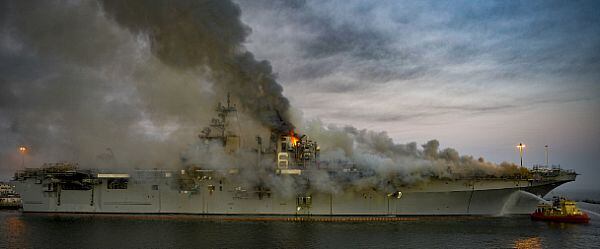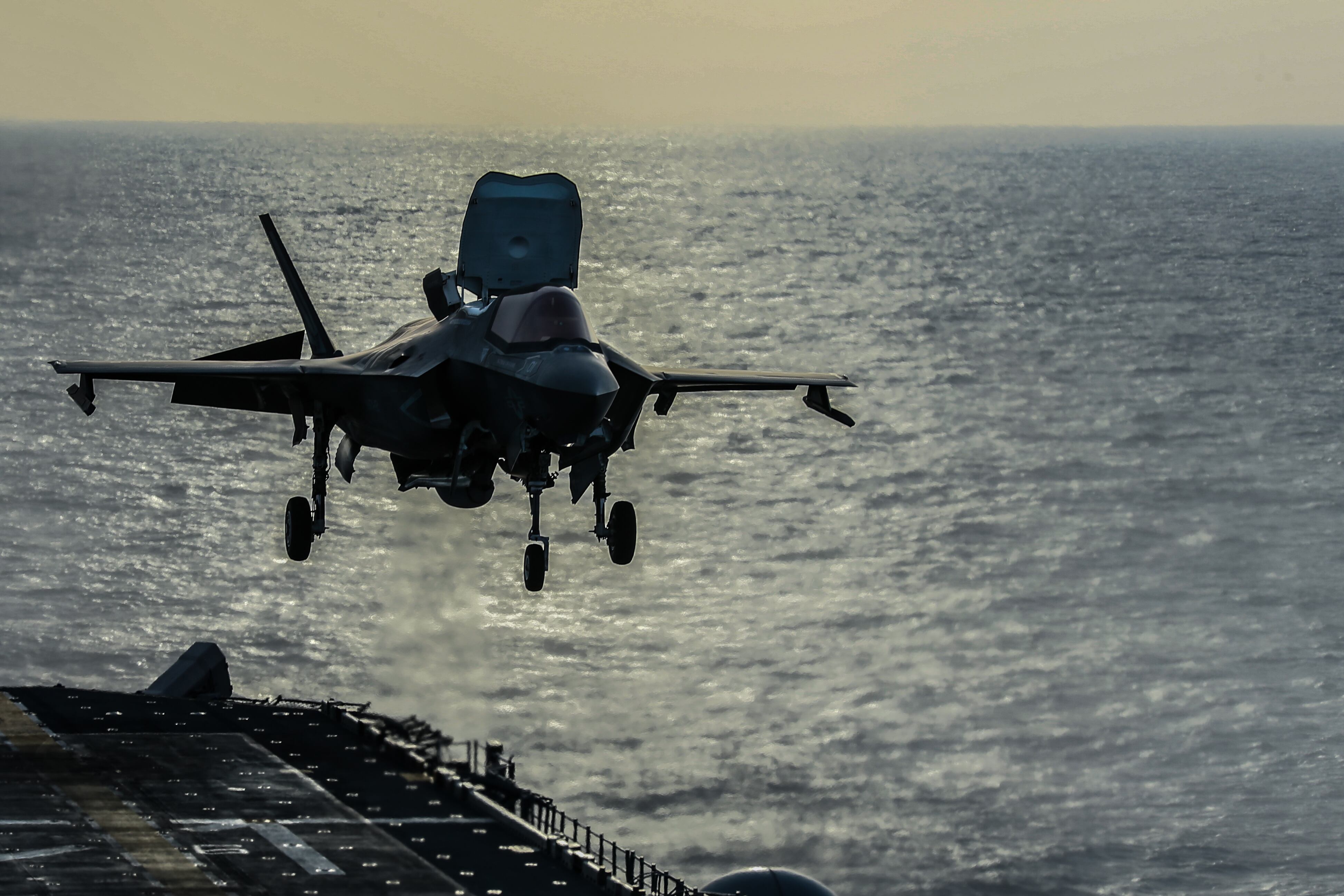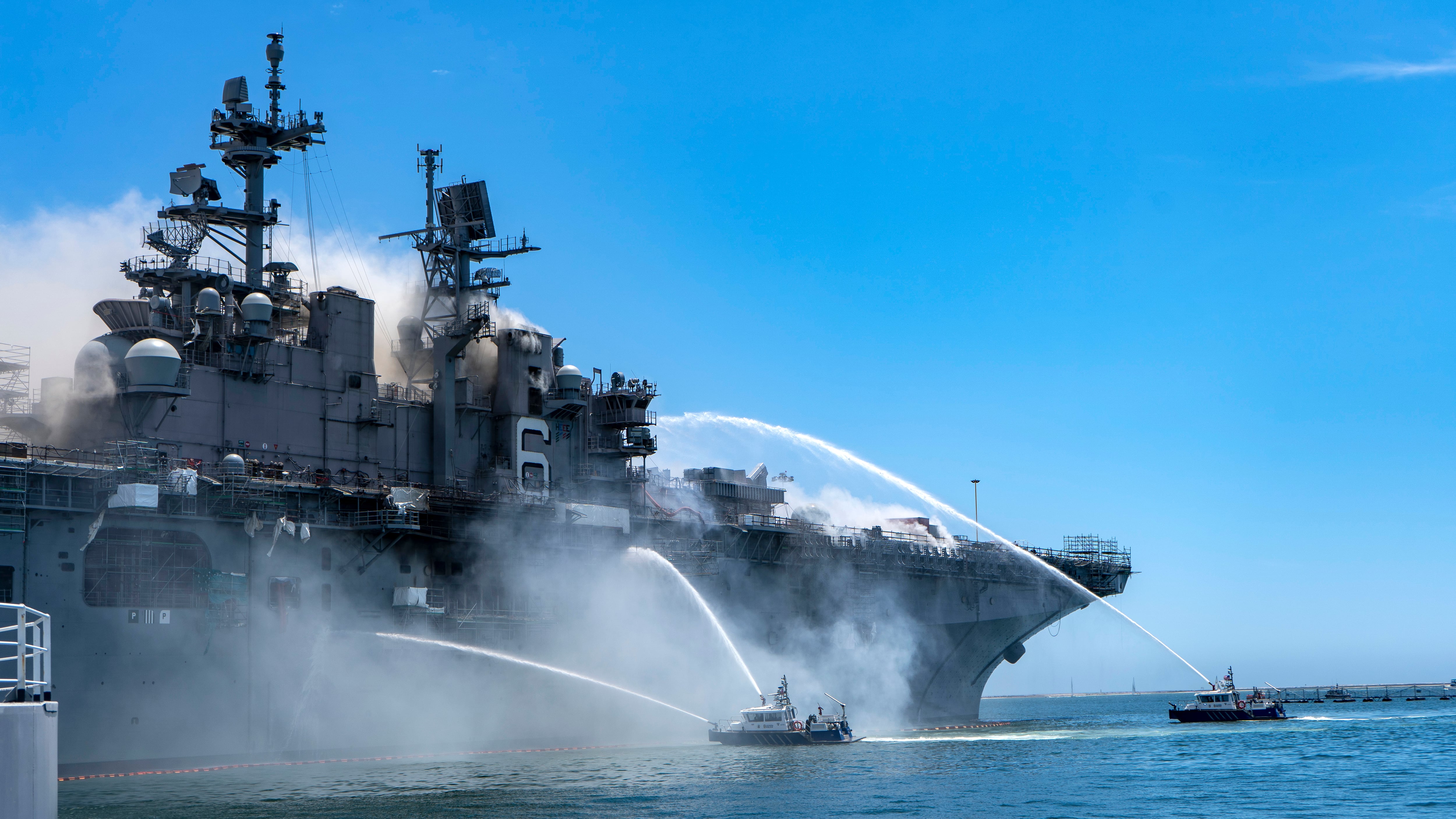WASHINGTON – The amphibious assault ship Bonhomme Richard, which burned through the night while in port in San Diego, was at the tail end of two years of upgrades supporting the integration of the F-35B, according to Navy documents.
That means the Navy will now have fewer options to deploy the next-generation fighter in the Pacific.
The Navy awarded the $219 million modernization contract to General Dynamics, National Steel and Shipbuilding Co. in 2018, which had options for up to $250 million. Bonhomme Richard is one of four large-deck amphibs to have received the upgrades. The Boxer was announced earlier this year as the fifth big-deck to get the upgrades.
Experts said the loss of Bonhomme Richard, whether a total loss or just lost for extensive repairs, deals a significant blow to the Navy’s plans to have F-35Bs continually deployed in the Pacific. And with Monday’s announcement that the United States had formally rejected China’s claims about the South China Sea, any accompanying boost in naval presence could be slowed by the fire.
The Navy’s deployment model is based on having permanent forward presence in vital regions, such as the Indo-Pacific and the Middle East. To accomplish that, the service needs enough ships to support one forward on deployment, one in an elevated status of readiness to surge in an emergency, one in maintenance and one in pre-deployment workups.
In other words, in an ideal world the Navy would have at least four ships to have one of them always on deployment. But with longer overhauls, such as the F-35B upgrades, it might require five ships to make one forward.
“It’s a big problem, considering the F-35B is the Department of the Navy’s only fielded and deployable 5th Generation generation fighter.” said Bryan Clark, a retired submarine officer and senior fellow at the Hudson Institute “We will want those deployed most of the time.
“Only half of [our 10 amphibious assault ships] are able to carry F-35B and the Marines are looking to reduce their land-based squadrons. So the loss of Bonhomme Richard will impact the Navy’s ability to provide Combatant Commanders sea-based F-35s not subject to host-nation approval.”

Jerry Hendrix, a retired Navy captain and analyst with Telemus Group, agreed, saying that the Navy’s posture in the Pacific is going to be challenged with Bonhomme Richard out of the lineup.
“It has a huge impact,” said Jerry Hendrix, a retired Navy captain and analyst with Telemus Group. “Bonhomme Richard has been in this overhaul for two years getting these upgrades to operate F-35Bs. She has about eight more years of life left in the hull, and so she was a central cog in our Pacific operational deployment plan for the next eight-to-10 years.”
The amphibious assault ship Tripoli is slated to be commissioned this month but will have as much as two years of work ups ahead of it, Hendrix noted, adding the Bonhomme Richard was supposed to be back in the rotation after its overhaul by the end of this year.
“This is a big hit in the Navy’s deployment plan over the next 10 years. Obviously we can’t just wave a magic wand and create another one,” Hendrix said.
The Navy could either ask the remaining amphibious assault ships to make longer deployments or it could dip into the inactive reserve fleet and bring back a Tarawa-class LHA to back-fill the capacity.
Bryan McGrath, a retired destroyer skipper and consultant with The Ferrybridge Group, likewise agreed that the fire would deal a blow to the Navy’s deployment plans.
“Obviously first and foremost someone is going to have to take her commitments,” he said. “Secondly, it is going to impact the fleet introduction of the F-35B and what does this do to the timeline that the Navy and Marine Corp were on for the regularization of that aircraft going to sea on that ship?
The fire also has implications for an ongoing effort to more closely align the Navy and Marine Corps in an effort Marine Commandant Gen. David Berger calls “naval integration,” McGrath said.
“There is this larger question of navy and Marine Corps integration that I think may be somewhat slowed by this because of the F-35 issue.”
The damage to the Bonhomme Richard has been extensive from stem to stern, engulfing the well deck, the super structure and the living and working spaces up forward. The forward mast has collapsed onto the superstructure and Expeditionary Strike Group Three commander Rear Adm. Phillip Sobeck told reporters Monday temperatures inside the skin of the ship have reached 1,000 degrees, a point at which steel is losing significant structural strength.
Hendrix guessed that the heat and duration of the fire likely means the ship is lost.
“I don’t think she’s coming back, I think she’ll be struck. I don’t think you have this intensity of heat and fire in a hull and give it a thumbs up
Lightning Carrier
The Navy has been using the Wasp-class amphibious assault ships, along with the follow-on America-class, to field a lighter, dedicated F-35 carrier, or “Lightning Carriers.”
But the idea of smaller carriers is one the Navy has been flirting with more recently. Last fall, the Navy packed 13 F-35Bs on the amphibious assault ship America. Then-Navy Secretary Spencer later said the ship could hold up to 20.
“I will tell you, we are augmenting the aircraft carrier with our ideas, such as this lightning carrier,” Spencer said at the Brookings Institution think tank. “Twenty F-35 Bravos on a large-deck amphib. My cost performance there is tremendous. Does it have the same punch? No, it doesn’t, but it does have a very interesting sting to it.”
The Wasp class, which is an older class of big-deck amphib, could likely pack about 15 F-35Bs if it were dedicated for the purpose, according to Clark, the Hudson Institute senior fellow.
The idea of a lighter carrier is also one that has intrigued Defense Secretary Mark Esper. In an interview with Defense News that coincided with the fiscal 21 budget rollout, Esper raised the possibility that lighter carriers were still on the agenda.
“There are various ways to do carriers,” Esper said. “So we can talk numbers or we can talk the sizes of carriers, right? There’s been discussion in the past about: Do you keep building big carriers, or do you go to smaller carriers, lightning carriers? Acting Secretary Modly and I have talked about that.
“I think this gets into the future fleet designs we look at. That will be one element that we look at.”

The Navy has shied away from lighter carriers for decades because, as expensive as the carriers are, the big supercarriers generate more sorties for less money than it would cost a comparable number of smaller carriers to generate.
But the utility of a smaller carrier that still has a mean bite was recently demonstrated when a COVID-19 outbreak on the carrier Theodore Roosevelt sidelined the flat top in Guam in the middle of its deployment. The Navy directed the America to the South China Sea to provide presence there to dissuade China from taking advantage of the Roosevelt’s misfortune.
That was a win for the idea of a smaller carrier, said Seth Cropsey, director of the Center for American Seapower at the Hudson Institute.
“The ability of the America to be on scene when the Roosevelt was not was a good thing,” he said. “Look I don’t think anyone is going to argue that it replaces a Ford-class carrier, but the idea of a more distributed force is a sensible one.
“I’m not saying that the Navy should stop building Ford-class carriers; I’m saying they should be including smaller carriers.”
David B. Larter was the naval warfare reporter for Defense News.





